The American Civil War was fought in the United States from 1861 until 1865 between the United States – forces coming mostly from the 23 northern states of the Union – and the newly-formed Confederate States of America, which consisted of 11 southern states that had declared their secession. There were various names used to describe the war itself, its combatants, armies, and battles.

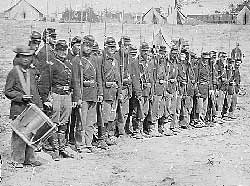 Seven states seceded shortly after the election of Abraham Lincoln in 1860 – even before he was inaugurated. They were South Carolina (December 20, 1860), Mississippi (January 9, 1861), Florida (January 10, 1861), Alabama (January 11, 1861), Georgia (January 19, 1861), Louisiana (January 26, 1861), and Texas (February 1, 1861). These Deep South States, where slavery and cotton plantation agriculture were most dominant, formed the Confederate States of America (February 4, 1861), with Jefferson Davis as President, and with a Constitution closely modeled on the U.S. Constitution. After the Battle of Fort Sumter, South Carolina, Lincoln called for troops from all remaining states to recover the forts, resulting in the secession of four more states: Virginia (April 17, 1861), Arkansas (May 6, 1861), North Carolina (May 20, 1861), and Tennessee (June 8, 1861). Seven states seceded shortly after the election of Abraham Lincoln in 1860 – even before he was inaugurated. They were South Carolina (December 20, 1860), Mississippi (January 9, 1861), Florida (January 10, 1861), Alabama (January 11, 1861), Georgia (January 19, 1861), Louisiana (January 26, 1861), and Texas (February 1, 1861). These Deep South States, where slavery and cotton plantation agriculture were most dominant, formed the Confederate States of America (February 4, 1861), with Jefferson Davis as President, and with a Constitution closely modeled on the U.S. Constitution. After the Battle of Fort Sumter, South Carolina, Lincoln called for troops from all remaining states to recover the forts, resulting in the secession of four more states: Virginia (April 17, 1861), Arkansas (May 6, 1861), North Carolina (May 20, 1861), and Tennessee (June 8, 1861).
Four "slave states" did not secede, and one seceding state split; these five are known as the Border States. Delaware, which had voted for John C. Breckinridge, had few slaves and never considered secession. Maryland also voted for Breckinridge; its legislature rejected secession (April 27, 1861), but only after the rioting in Baltimore and other events had prompted a federal declaration of martial law. Missouri and Kentucky remained in the Union, but in both, factions organized "secessions", which were recognized by the Confederate States of America. In Missouri, the State government under Governor Claiborne F. Jackson, a southern sympathizer, evacuated the state capital of Jefferson City when it was attacked by northern Gen. Nathaniel Lyon on June 14, 1861. The southern half of the federal territory of New Mexico voted to secede, and was accepted into the Confederacy as the Territory of Arizona, with its capital in Mesilla (now New Mexico). California was a free state and a part of the Union. Lincoln had won a plurality there, but there was a number of Southern Sympathizers. 28% of its votes went to the Southern Democrat candidate, John C. Breckinridge. California was asked to keep its soldiers under state control and were used to keep the land routes between the Mississippi and the state open. California gold helped finance the Union war effort.

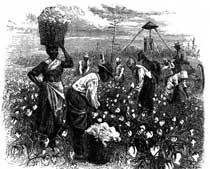 Slave "patrollers," mostly poor whites, were given the authority to stop, search, whip, maim, and even kill any slave who violated the slave codes. In their agitation against the South, abolitionists cited the slave codes as example of the barbarism of Southern society. On the eve of the Civil War, the United States was a nation divided into four quite distinct regions: the Northeast, with a growing industrial and commercial economy and an increasing density of population; the Northwest, now known as the Midwest, a rapidly expanding region of free farmers where slavery had been forever prohibited under the Northwest Ordinance; the Upper South, with a settled plantation system and (in some areas) declining economic fortunes; and the Southwest, a booming frontier-like region with expanding cotton economy. With two fundamentally different labor systems at their base, the economic and social changes across the nation's geographical regions – based on wage labor in the North and on slavery in the South – underlay distinct visions of society that had emerged by the mid-nineteenth century in the North and in the South. Slave "patrollers," mostly poor whites, were given the authority to stop, search, whip, maim, and even kill any slave who violated the slave codes. In their agitation against the South, abolitionists cited the slave codes as example of the barbarism of Southern society. On the eve of the Civil War, the United States was a nation divided into four quite distinct regions: the Northeast, with a growing industrial and commercial economy and an increasing density of population; the Northwest, now known as the Midwest, a rapidly expanding region of free farmers where slavery had been forever prohibited under the Northwest Ordinance; the Upper South, with a settled plantation system and (in some areas) declining economic fortunes; and the Southwest, a booming frontier-like region with expanding cotton economy. With two fundamentally different labor systems at their base, the economic and social changes across the nation's geographical regions – based on wage labor in the North and on slavery in the South – underlay distinct visions of society that had emerged by the mid-nineteenth century in the North and in the South.
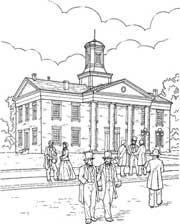 Before the Civil War, the Constitution provided a basis for peaceful debate over the future of government, and had been able to regulate conflicts of interest and conflicting visions for the new, rapidly expanding nation. For many years, compromises had been made to balance the number of "free states" and "slave states" so that there would be a balance in the Senate. The last slave state admitted was Texas in 1845, with five free states admitted between 1846 and 1859. Kansas's admission as a slave state had recently been blocked, and it was due to enter as a free state instead in 1861. The rise of mass democracy in the industrializing North, the breakdown of the old two-party system, and increasingly virulent and hostile sectional ideologies in the mid-nineteenth century made it highly unlikely, if not impossible, to bring about the gentlemanly compromises of the past (such as the Missouri Compromise and the Compromise of 1850) necessary to avoid crisis. Before the Civil War, the Constitution provided a basis for peaceful debate over the future of government, and had been able to regulate conflicts of interest and conflicting visions for the new, rapidly expanding nation. For many years, compromises had been made to balance the number of "free states" and "slave states" so that there would be a balance in the Senate. The last slave state admitted was Texas in 1845, with five free states admitted between 1846 and 1859. Kansas's admission as a slave state had recently been blocked, and it was due to enter as a free state instead in 1861. The rise of mass democracy in the industrializing North, the breakdown of the old two-party system, and increasingly virulent and hostile sectional ideologies in the mid-nineteenth century made it highly unlikely, if not impossible, to bring about the gentlemanly compromises of the past (such as the Missouri Compromise and the Compromise of 1850) necessary to avoid crisis.
Sectional tensions changed in their nature and intensity rapidly during the 1850s. The United States Republican Party was established in 1854. The new party opposed the expansion of slavery in the Western territories. Although only a small share of Northerners favored measures to abolish slavery in the South, the Republicans were able to mobilize popular support among Northerners and Westerns who did not want to compete against slave labor if the system were expanded beyond the South. The Republicans won the support of many ex-Whigs and Northern ex-Democrats concerned about the South's disproportionate influence in the Senate, the Buchanan administration, and the Supreme Court. Meanwhile, the profitability of cotton, or "King Cotton," as it was touted, solidified the South's dependence on the plantation system and its foundation: slave labor. A small class of slave barons, especially cotton planters, dominated the politics and society of the South.

 Southern secession was triggered by the election of Republican Abraham Lincoln. Lincoln was a moderate in his opposition to slavery. He pledged to do all he could to oppose the expansion of slavery into the territories (thus also preventing the admission of any additional slave states to the Union); but he also said the federal government did not have the power to abolish slavery in the states in which it already existed, and that he would enforce Fugitive Slave Laws. The southern states expected increasing hostility to their "peculiar institution"; not trusting Lincoln, and mindful that many other Republicans were intent on complete abolition of slavery. Lincoln had even encouraged abolitionists with his 1858 "House divided" speech, though that speech was also consistent with an eventual end of slavery achieved gradually and voluntarily with compensation to slave-owners and resettlement of former slaves. Southern secession was triggered by the election of Republican Abraham Lincoln. Lincoln was a moderate in his opposition to slavery. He pledged to do all he could to oppose the expansion of slavery into the territories (thus also preventing the admission of any additional slave states to the Union); but he also said the federal government did not have the power to abolish slavery in the states in which it already existed, and that he would enforce Fugitive Slave Laws. The southern states expected increasing hostility to their "peculiar institution"; not trusting Lincoln, and mindful that many other Republicans were intent on complete abolition of slavery. Lincoln had even encouraged abolitionists with his 1858 "House divided" speech, though that speech was also consistent with an eventual end of slavery achieved gradually and voluntarily with compensation to slave-owners and resettlement of former slaves.
In addition to Lincoln's presidential victory, the slave states had lost the balance of power in the Senate and were facing a future as a perpetual minority after decades of nearly continuous control of the presidency and the Congress. Southerners also felt they could no longer prevent protectionist tariffs such as the Morrill Tariff, which generally placed a greater burden upon the South. The Southern justification for a unilateral right to secede cited the doctrine of states' rights, which had been debated before with the 1798 Kentucky and Virginia Resolutions, the Hartford Convention during the War of 1812, and the 1832 Nullification Crisis with regard to tariffs.
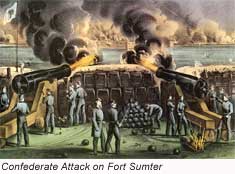 Before Lincoln took office, seven states seceded from the union, establishing a rebel government, the Confederate States of America on February 9, 1861. They took control of federal forts and property within their boundaries, with little resistance from President Buchanan. Ironically, by seceding, the rebel states weakened any claim to the territories that were in dispute, cancelled any obligation for the North to return fugitive slaves, and assured easy passage of many bills and amendments they had long opposed. The Civil War began when Confederate General P.G.T. Beauregard opened fire upon Fort Sumter in Charleston, South Carolina on April 12, 1861. There were no casualties in this battle but there would be in the years to come. Before Lincoln took office, seven states seceded from the union, establishing a rebel government, the Confederate States of America on February 9, 1861. They took control of federal forts and property within their boundaries, with little resistance from President Buchanan. Ironically, by seceding, the rebel states weakened any claim to the territories that were in dispute, cancelled any obligation for the North to return fugitive slaves, and assured easy passage of many bills and amendments they had long opposed. The Civil War began when Confederate General P.G.T. Beauregard opened fire upon Fort Sumter in Charleston, South Carolina on April 12, 1861. There were no casualties in this battle but there would be in the years to come.
Lincoln's victory in the presidential election of 1860 triggered South Carolina's secession from the Union. Lincoln was not even on the ballot in nine states in the South. Leaders in South Carolina had long been waiting for an event that might unite the South against the antislavery forces. Once the election returns were certain, a special South Carolina convention declared "that the Union now subsisting between South Carolina and other states under the name of the 'United States of America' is hereby dissolved." By February 1, 1861, six more Southern states had seceded. On February 7, the seven states adopted a provisional constitution for the Confederate States of America and established their capital at Montgomery, Alabama. The pre-war peace conference of 1861 met at Washington, D.C. The remaining southern states as yet remained in the Union. Several seceding states seized federal forts within their boundaries; President Buchanan made no military response.
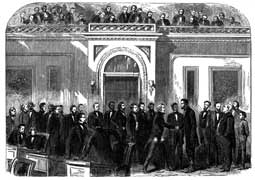 Less than a month later, on March 4, 1861, Abraham Lincoln was sworn in as President of the United States. In his inaugural address, he argued that the Constitution was a more perfect union than the earlier Articles of Confederation and Perpetual Union, that it was a binding contract, and called the secession "legally void". He stated he had no intent to invade southern states, but would use force to maintain possession of federal property. His speech closed with a plea for restoration of the bonds of union. The South, particularly South Carolina, ignored the plea, and on April 12, the South fired upon the Federal troops stationed at Fort Sumter in Charleston, South Carolina until the troops surrendered. Less than a month later, on March 4, 1861, Abraham Lincoln was sworn in as President of the United States. In his inaugural address, he argued that the Constitution was a more perfect union than the earlier Articles of Confederation and Perpetual Union, that it was a binding contract, and called the secession "legally void". He stated he had no intent to invade southern states, but would use force to maintain possession of federal property. His speech closed with a plea for restoration of the bonds of union. The South, particularly South Carolina, ignored the plea, and on April 12, the South fired upon the Federal troops stationed at Fort Sumter in Charleston, South Carolina until the troops surrendered.

Lincoln called for all of the states in the Union to send troops to recapture the forts and preserve the Union. Most Northerners believed that a quick brutal victory for the Union would crush the nascent rebellion, and so Lincoln only called for volunteers for 90 days. This resulted in four more states voting to secede. Once Virginia seceded, the Confederate capital was moved to Richmond, Virginia. Even though the Southern states had seceded, there was considerable anti-secessionist sentiment within several of the seceding states. Eastern Tennessee, in particular, was a hotbed for pro-Unionism. Winston County, Alabama issued a resolution of secession from the state of Alabama. The Red Strings were a prominent Southern anti-secession group.
As a Confederate force was built up by July 1861 at Manassas, Virginia, a march by Union troops under the command of Maj. Gen. Irvin McDowell on the Confederate forces there was halted in the First Battle of Bull Run, or First Manassas, whereupon they were forced back to Washington, D.C., by Confederate troops under the command of Generals Joseph E. Johnston and P.G.T. Beauregard. It was in this battle that Confederate General Thomas Jackson received the name of "Stonewall" because he stood like a stone wall against Union troops. Alarmed at the loss, and in an attempt to prevent more slave states from leaving the Union, the U.S. Congress passed the Crittenden-Johnson Resolution on July 25 of that year, which stated that the war was being fought to preserve the Union and not to end slavery. Major General George B. McClellan took command of the Union Army of the Potomac on July 26 (he was briefly general-in-chief of all the Union armies, but was subsequently relieved of that post in favor of Maj. Gen. Henry W. Halleck), and the war began in earnest in 1862.
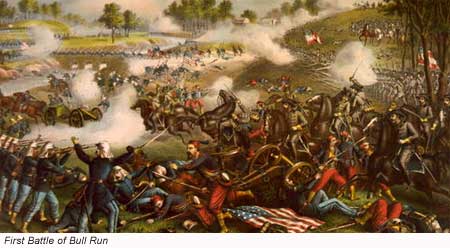
Upon the strong urging of President Lincoln to begin offensive operations, McClellan invaded Virginia in the spring of 1862 by way of the peninsula between the York River and James River, southeast of Richmond. Although McClellan's army reached the gates of Richmond in the Peninsula Campaign, Joseph E. Johnston halted his advance at the Battle of Seven Pines, then Robert E. Lee defeated him in the Seven Days Battles and forced his retreat. McClellan was stripped of many of his troops to reinforce John Pope's Union Army of Virginia. Pope was beaten spectacularly by Lee in the Northern Virginia Campaign and the Second Battle of Bull Run in August.
Emboldened by Second Bull Run, the Confederacy made its first invasion of the North, when General Lee led 55,000 men of the Army of Northern Virginia across the Potomac River into Maryland on September 5. Lincoln then restored Pope's troops to McClellan. McClellan and Lee fought at the Battle of Antietam near Sharpsburg, Maryland, on September 17, 1862, the bloodiest single day in American history. Lee's army, checked at last, returned to Virginia before McClellan could destroy it. Antietam is considered a Union victory because it halted Lee's invasion of the North and provided justification for Lincoln to announce his Emancipation Proclamation.
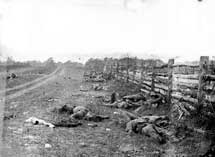 When the cautious McClellan failed to follow up on Antietam, he was replaced by Maj. Gen. Ambrose Burnside. Burnside suffered near-immediate defeat at the Battle of Fredericksburg on December 13, 1862, when over ten thousand Union soldiers were killed or wounded. After the battle, Burnside was replaced by Maj. Gen. Joseph "Fighting Joe" Hooker. Hooker, too, proved unable to defeat Lee's army; despite outnumbering the Confederates by more than two to one, he was humiliated in the Battle of Chancellorsville in May 1863. He was replaced by Maj. Gen. George G. Meade during Lee's second invasion of the North, in June. Meade defeated Lee at the Battle of Gettysburg (July 1–3, 1863), the largest battle in North American history, which is sometimes considered the war's turning point. Lee's army suffered 28,000 casualties (versus Meade's 23,000), again forcing it to retreat to Virginia, never to launch a full-scale invasion of the North again. When the cautious McClellan failed to follow up on Antietam, he was replaced by Maj. Gen. Ambrose Burnside. Burnside suffered near-immediate defeat at the Battle of Fredericksburg on December 13, 1862, when over ten thousand Union soldiers were killed or wounded. After the battle, Burnside was replaced by Maj. Gen. Joseph "Fighting Joe" Hooker. Hooker, too, proved unable to defeat Lee's army; despite outnumbering the Confederates by more than two to one, he was humiliated in the Battle of Chancellorsville in May 1863. He was replaced by Maj. Gen. George G. Meade during Lee's second invasion of the North, in June. Meade defeated Lee at the Battle of Gettysburg (July 1–3, 1863), the largest battle in North American history, which is sometimes considered the war's turning point. Lee's army suffered 28,000 casualties (versus Meade's 23,000), again forcing it to retreat to Virginia, never to launch a full-scale invasion of the North again.
While the Confederate forces had numerous successes in the Eastern theater, they crucially failed in the West. Confederate forces were driven from Missouri early in the war as result of the Battle of Pea Ridge. Leonidas Polk's invasion of Kentucky enraged the citizens who previously had declared neutrality in the war, turning that state against the Confederacy.
Nashville, Tennessee fell to the Union early in 1862. Most of the Mississippi was opened with the taking of Island No. 10 and New Madrid, Missouri, and then Memphis, Tennessee. New Orleans, Louisiana, was captured in May, 1862, allowing the Union forces to begin moving up the Mississippi as well. Only the fortress city of Vicksburg, Mississippi prevented unchallenged Union control of the entire river. Braxton Bragg's second Confederate invasion of Kentucky was repulsed at the confused and bloody Battle of Perryville and he was narrowly defeated by William S. Rosecrans at the Battle of Stones River in Tennessee.
The one clear Confederate victory in the West was the Battle of Chickamauga in Tennessee, near the Georgia border, where Bragg, reinforced by the corps of James Longstreet (from Lee's army in the east), defeated Rosecrans despite the heroics of George Henry Thomas and forced him to retreat to Chattanooga, which Bragg then besieged. The Union's key strategist and tactician in the west was Maj. Gen. Ulysses S. Grant, who won victories at Fort Henry, Fort Donelson, Shiloh, Vicksburg, Mississippi, and Chattanooga, Tennessee, driving Confederate forces out of Tennessee.
Though geographically isolated from the battles to the east, a number of military actions took place in the Trans-Mississippi theater, a region encompassing states and territories to the west of the Mississippi River. In 1861 Confederates launched a successful campaign into the territory of present day Arizona and New Mexico. Residents in the southern portions of this territory adopted a secession ordinance of their own and requested that Confederate forces stationed in nearby Texas assist them in removing Union forces still stationed there. The Confederate territory of Arizona was proclaimed by Col. John Baylor after victories at Mesilla, New Mexico, and the capture of several Union forces. Confederate troops were unsuccessful in attempts to press northward in the territory and withdrew from Arizona completely in 1862 as Union reinforcements arrived from California.
The Battle of Glorieta Pass was a small skirmish in terms of both numbers involved and losses (140 Federal, 190 Confederate). Yet the issues were large, and the battle decisive in resolving them. The Confederates might well have taken Fort Union and Denver had they not been stopped at Glorieta. As one Texan put it, "if it had not been for those devils from Pike's Peak, this country would have been ours". This small battle smashed any possibility of the Confederacy taking New Mexico and the far west territories. In April, Union volunteers from California pushed the remaining Confederates out of present-day Arizona at the Battle of Pichaco Peak. In the eastern part of the United States, the fighting dragged on for three more years, but in the Southwest the war was over.
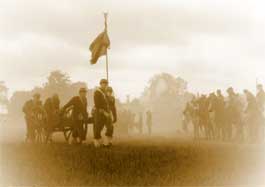 The Union mounted several attempts to capture the trans-Mississippi regions of Texas and Louisiana from 1862 until the war's end. With ports to the east under blockade or capture, Texas in particular became a blockade-running haven. Referred to as the "back door" of the Confederacy, Texas and western Louisiana continued to provide cotton crops that were transferred overland to Matamoros, Mexico, and shipped to Europe in exchange for supplies. Determined to close this trade, the Union mounted several invasion attempts of Texas, each of them unsuccessful. Confederate victories at Galveston, Texas, and the Battle of Sabine Pass repulsed invasion forces. The Union's disastrous Red River Campaign in western Louisiana, including a defeat at the Battle of Mansfield, effectively ended the Union's final invasion attempt of the region until the final fall of the Confederacy. Isolated from events in the east, the Civil War continued in the Trans-Mississippi theater for several months after Robert E. Lee's surrender. The last battle of the war occurred at Palmito Ranch in southern Texas—ironically a Confederate victory. The Union mounted several attempts to capture the trans-Mississippi regions of Texas and Louisiana from 1862 until the war's end. With ports to the east under blockade or capture, Texas in particular became a blockade-running haven. Referred to as the "back door" of the Confederacy, Texas and western Louisiana continued to provide cotton crops that were transferred overland to Matamoros, Mexico, and shipped to Europe in exchange for supplies. Determined to close this trade, the Union mounted several invasion attempts of Texas, each of them unsuccessful. Confederate victories at Galveston, Texas, and the Battle of Sabine Pass repulsed invasion forces. The Union's disastrous Red River Campaign in western Louisiana, including a defeat at the Battle of Mansfield, effectively ended the Union's final invasion attempt of the region until the final fall of the Confederacy. Isolated from events in the east, the Civil War continued in the Trans-Mississippi theater for several months after Robert E. Lee's surrender. The last battle of the war occurred at Palmito Ranch in southern Texas—ironically a Confederate victory.
 At the beginning of 1864, Grant was promoted to lieutenant general and given command of all Union armies. He chose to make his headquarters with the Army of the Potomac although Meade remained the actual commander of that army. He left Maj. Gen. William Tecumseh Sherman in command of most of the western armies. Grant understood the concept of total war and believed, along with Lincoln and Sherman, that only the utter defeat of Confederate forces and their economic base would bring an end to the war. Therefore, scorched earth tactics would be required in some important theaters. He devised a coordinated strategy that would strike at the heart of Confederacy from multiple directions: Grant, Meade, and Benjamin Butler against Lee near Richmond; Franz Sigel in the Shenandoah Valley; Sherman to invade Georgia, defeat Joseph E. Johnston, and capture Atlanta; George Crook and William W. Averell to operate against railroad supply lines in West Virginia; Nathaniel Banks to capture Mobile, Alabama. At the beginning of 1864, Grant was promoted to lieutenant general and given command of all Union armies. He chose to make his headquarters with the Army of the Potomac although Meade remained the actual commander of that army. He left Maj. Gen. William Tecumseh Sherman in command of most of the western armies. Grant understood the concept of total war and believed, along with Lincoln and Sherman, that only the utter defeat of Confederate forces and their economic base would bring an end to the war. Therefore, scorched earth tactics would be required in some important theaters. He devised a coordinated strategy that would strike at the heart of Confederacy from multiple directions: Grant, Meade, and Benjamin Butler against Lee near Richmond; Franz Sigel in the Shenandoah Valley; Sherman to invade Georgia, defeat Joseph E. Johnston, and capture Atlanta; George Crook and William W. Averell to operate against railroad supply lines in West Virginia; Nathaniel Banks to capture Mobile, Alabama.
Union forces in the East attempted to maneuver past Lee and fought several battles during that phase of the Eastern campaign, known as Grant's Overland Campaign. An attempt to outflank Lee from the south failed under Butler, who was corked into the Bermuda Hundred river bend. Grant was tenacious and, despite astonishing losses (over 66,000 casualties in six weeks), kept pressing the Lee's Army of Northern Virginia. He pinned down the Confederate army in the Siege of Petersburg, where the two armies engaged in trench warfare for over nine months.
After two failed attempts (under Sigel and David Hunter) to seize key points in the Shenandoah Valley, Grant finally found a commander, Philip Sheridan, aggressive enough to prevail in the Valley Campaigns of 1864. Sheridan was sent as a result of a raid by the aggressive Jubal Early, whose corps reached the outer defenses of Washington, alarming the federal government, before withdrawing back to the Valley. Sheridan proved to be more than a match for Early, and defeated him in a series of battles, decisively at Cedar Creek, and proceeded to destroy the agricultural and industrial base of the Valley, similar to the scorched-earth tactics Sherman would employ in Georgia.
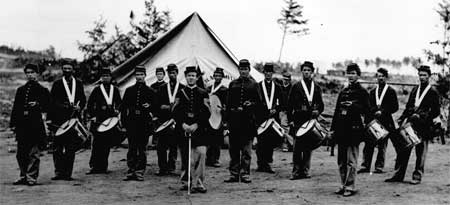
Meanwhile, Sherman marched from Chattanooga to Atlanta, Georgia, defeating Generals Joseph E. Johnston and John B. Hood. The fall of Atlanta on September 2, 1864, was a significant factor in re-electing Abraham Lincoln. Leaving Atlanta, and his base of supplies, Sherman's army marched with an unclear destination, laying waste to much of the rest of Georgia in his celebrated Sherman's March to the Sea, reaching the sea at Savannah, Georgia in December, 1864. Burning towns and plantations as they went, Sherman's armies hauled off crops and killed livestock to retaliate and to deny use of these economic assets to the Confederacy, a consequence of Grant's scorched earth doctrine. When Sherman turned north through South Carolina and North Carolina to approach the Virginia lines from the south, it was the end for Lee and his men, and for the Confederacy.
Lee attempted to escape from the besieged Petersburg and link up with Johnston in North Carolina, but he was overtaken by Grant. He surrendered his Army of Northern Virginia on April 9, 1865, at Appomattox Court House. Johnston surrendered his troops to Sherman shortly thereafter. The Battle of Palmito Ranch, fought on May 13, 1865, in the far south of Texas, was the last land battle of the war and ended, ironically, with a Confederate victory. All Confederate land forces surrendered by June 1865. Confederate naval units surrendered as late as November 1865, with the last actions being attacks on private New England whaling ships by the CSS Shenandoah in the Bering Strait through June 28, 1865.
 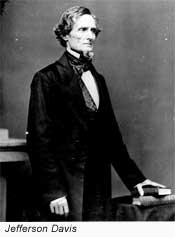 As slavery and constitutional questions concerning states' rights were widely viewed as causes for the war, the victorious Union government sought to end slavery and to strip the states of their powers to define citizenship and to deny residents fundamental rights. During the early part of the war, Lincoln, to hold together his war coalition of Republicans and War Democrats, emphasized preservation of the Union as the sole Union objective of the war, but with the Emancipation Proclamation, announced in September 1862 and put into effect four months later, Lincoln adopted the abolition of slavery as a second mission. The Emancipation Proclamation declared all slaves held in territory then under Confederate control to be "then, thenceforth, and forever free." It had little initial effect but served to commit the United States to the goal of ending slavery. The Proclamation would be put into practical effect in Confederate territory captured over the remainder of the war. As slavery and constitutional questions concerning states' rights were widely viewed as causes for the war, the victorious Union government sought to end slavery and to strip the states of their powers to define citizenship and to deny residents fundamental rights. During the early part of the war, Lincoln, to hold together his war coalition of Republicans and War Democrats, emphasized preservation of the Union as the sole Union objective of the war, but with the Emancipation Proclamation, announced in September 1862 and put into effect four months later, Lincoln adopted the abolition of slavery as a second mission. The Emancipation Proclamation declared all slaves held in territory then under Confederate control to be "then, thenceforth, and forever free." It had little initial effect but served to commit the United States to the goal of ending slavery. The Proclamation would be put into practical effect in Confederate territory captured over the remainder of the war.
The border States of Missouri and Maryland moved during the course of the war to end slavery, and in December 1864, the Congress proposed the 13th Amendment to the United States Constitution, barring slavery throughout the United States; the 13th Amendment was fully ratified by the end of 1865. The 14th Amendment, defining citizenship and giving the Federal government broad power to require the States to provide equal protection of the laws was adopted in 1868. The 15th Amendment guaranteeing black Americans the right to vote was ratified in 1870. The 14th and 15th Amendments reversed the effects of the Supreme Court's Dred Scott decision of 1857, but the 14th Amendment, in particular, had unanticipated and far-reaching effects. The expansion of fundamental rights under the 14th Amendment's first clause, requiring due process and equal protection for all citizens, was not anticipated by its sponsors. Under this clause the Supreme Court later recognized such rights as the right to abortion, the right to contraceptives, the right to medical treatment, and the right to marry.
 According to data from the United States Department of Veterans Affairs, the last surviving Union veteran of the conflict, Albert Woolson, died on August 2, 1956 at the age of 109, and the last Confederate veteran, John Salling, died on March 16, 1958, at the age of 112. However, William Marvel investigated the claims of both for a 1991 piece in the Civil War history magazine Blue & Gray. Using census information, he found that Salling was born in 1858, far too late to have served in the Civil War. In fact, he concluded, "Every one of the last dozen recognized Confederates was bogus." He found Woolson to be the last true veteran of the Civil War on either side; he had served as a drummer boy late in the war. After the war, the Grand Army of the Republic, a fraternal organization open to Union war veterans, was founded in 1866. Confederate veterans formed the United Confederate Veterans in 1889. In 1905, a campaign medal was authorized for all Civil War veterans, known as the Civil War Campaign Medal. According to data from the United States Department of Veterans Affairs, the last surviving Union veteran of the conflict, Albert Woolson, died on August 2, 1956 at the age of 109, and the last Confederate veteran, John Salling, died on March 16, 1958, at the age of 112. However, William Marvel investigated the claims of both for a 1991 piece in the Civil War history magazine Blue & Gray. Using census information, he found that Salling was born in 1858, far too late to have served in the Civil War. In fact, he concluded, "Every one of the last dozen recognized Confederates was bogus." He found Woolson to be the last true veteran of the Civil War on either side; he had served as a drummer boy late in the war. After the war, the Grand Army of the Republic, a fraternal organization open to Union war veterans, was founded in 1866. Confederate veterans formed the United Confederate Veterans in 1889. In 1905, a campaign medal was authorized for all Civil War veterans, known as the Civil War Campaign Medal.
From the election of 1876 until the election of 1964, Georgia, Alabama, Mississippi, and Arkansas gave no electoral votes to the Republican Party, with South Carolina and Louisiana making an exception only once each. Most other states that had seceded voted overwhelmingly against Republican presidential nominees also, with the same trend predominantly applying in state elections too. This phenomenon was known as the Solid South. However, starting with the election of 1964, this trend has almost completely reversed, and most of the Southern states have now become Republican strongholds.
A good deal of ill will among the Southern survivors resulted from the consequent shift of political power to the North, the destruction inflicted on the South by the Union armies as the end of the war approached, and the Reconstruction program instituted in the South by the Union after the war's end. Bitterness about the war continued for decades after the war ended. Many southerners still do not accept the outcome, and it entrenched northern antipathy toward the south. Confederate flags and bumper stickers that say "The South shall rise again" are sometimes seen in various parts of the South. Heated political debates still occur over the use of symbols like Confederate Flags and images of Lincoln in public life. When asked, the flag's proponents argue that it does not signify any type of prejudice or racism, but is instead a symbol of the bond the southern states share; others, especially black Americans, disagree.
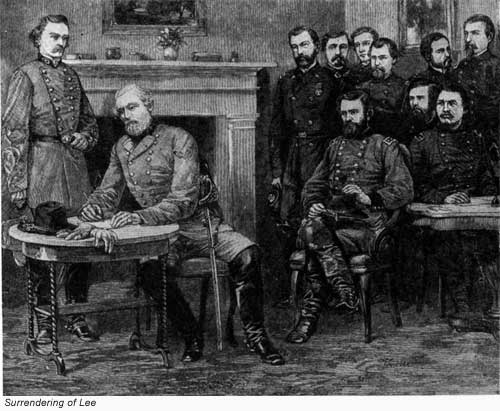
|